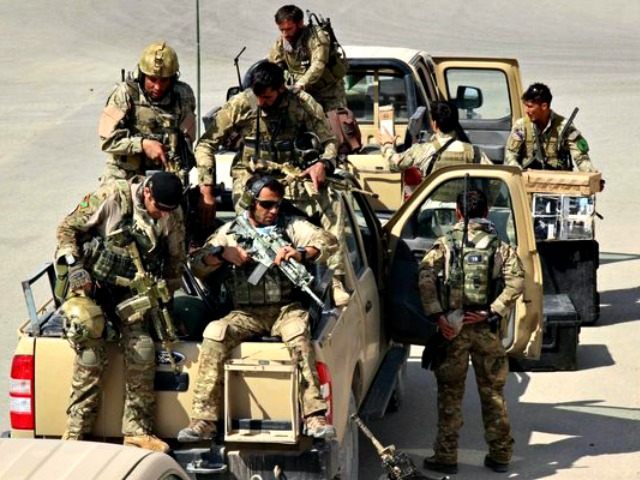WASHINGTON, D.C. — The Pentagon lacks a reliable system to gauge whether the Afghan security troops are an effective fighting force capable of holding its ground against the enemies of Afghanistan, such as the Taliban and the Islamic State (ISIS/ISIL), reports a congressionally appointed watchdog agency.
That revelation comes on the heels of the United Nations declaring that “the intensity of conflict in Afghanistan shows no signs of abating and the security environment has become more fragile and dynamic” less than a year after President Obama declared an end to the U.S. combat mission, notes the Special Inspector General for Afghanistan Reconstruction (SIGAR), an independent watchdog agency, in its 29th quarterly report to Congress.
A capable and self-sustaining Afghan National Defense and Security Force (ANDSF), which includes army and police units, is vital to preventing Afghanistan from once again becoming a safe haven for terrorists who can launch attacks against the U.S. and destabilize the region.
The ANDSF took over security operations when Obama and NATO ended their combat mission in Afghanistan in December 2014, withdrawing most of their forces at a time when Afghan civilians and security forces were suffering a record number of casualties.
The number of Afghan civilians and security forces killed and wounded by the Taliban remains at historic levels.
SIGAR notes that the tool used to assess the ANDSF does not “provide a clear picture of ANDSF capability.”
“One of the most important questions facing Afghanistan has long been whether the Afghan National Defense and Security Forces (ANDSF) can maintain security following the U.S. and Coalition military drawdown,” reports SIGAR, later adding, “SIGAR and other organizations have long voiced concern about the ANDSF’s capability to counter the threats facing them in the foreseeable future.”
The current capability rating tool is officially known as the Monthly ANDSF Assessment Reports (MAAR).
This quarter, U.S. Forces-Afghanistan (USFOR-A) informed the Special Inspector General that MAAR was “not intended to be used as an assessment or evaluation [of] the entire ANDSF.”
The U.S. military’s evaluation of MAAR “raises a serious concern that the United States does not have a reliable system to actually rate the capability of the ANDSF [at an operational level] and, by extension, the effectiveness of the United States’ $65 billion investment to build, train, equip, and sustain them,” notes John Sopko, the special inspector general, in the report.
“Under the circumstances, SIGAR cannot evaluate the progress of ANA [Afghan National Army] corps or police units and their operational capabilities this quarter,” adds Sopko.
The inspector general included ANDSF capabilities in SIGAR’s High-Risk List back in December 2014, urging attention to areas susceptible to waste, fraud, and abuse.
“SIGAR has repeatedly raised concerns about ANDSF capabilities and will continue to monitor closely their performance,” reports Sopko in the 256-page report.
The U.S. Forces-Afghanistan, a component of the Department of Defense (DOD), has reportedly offered to provide SIGAR with an unclassified narrative in the future that provides “a comprehensive assessment” of the Afghan security troops.
“It was not clear why USFOR-A had not previously provided this type of assessment despite SIGAR’s quarterly requests for ANDSF capability assessments,” notes the inspector general.
MAAR is just the latest scheme used to assess the capabilities of the Afghan forces. DOD has changed the assessment tool four times in the last ten years.
The MAAR assessment ratings, in ascending order, are: not rated, in development, partially capable, capable, fully capable, and sustaining.
DOD attributed the decrease in Afghan forces capabilities reflected in the assessment provided to SIGAR last quarter to the significant stresses of the fighting season.
Last quarter, the ANDSF was ranked as “less capable” than during the previous three months.
“The ANDSF suffered decreases in a number of areas early in the fighting season, but have begun to recover in some areas as they gain experience,” notes SIGAR. “Other areas will likely not recover until after the fighting season when the ANDSF have time to reconstitute their forces.”
While testifying before the Senate Armed Services Committee on October 6, Gen. John Campbell, the top commander of U.S. and NATO forces in Afghanistan, described the Taliban’s brief occupation of Kunduz, the first provincial capital to fall into the hands of the insurgents since 2001, and underscored several ANDSF shortcomings.
Without the combat power and numbers necessary to provide security across Afghanistan, the general told lawmakers, the Afghan security forces will face a difficulty countering the Taliban’s ability to temporarily seize territory.
“They (ANDSF) do not possess the necessary combat power and numbers to protect every part of the country,” he said, adding that the Afghan forces need to improve responsiveness, flexibility, and preparedness at the tactical and operational levels.
ANDSF leaders need to discern when to take the offense, when to defend, and where to assume risk, he also said.
“The ease with which a relatively small number of Taliban fighters overran Kunduz [in September] called into question the leadership and readiness of the Afghan National Defense and Security Forces (ANDSF),” declared the inspector general.

COMMENTS
Please let us know if you're having issues with commenting.